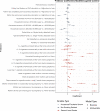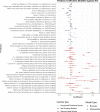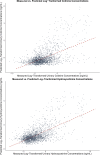Assessing secondhand and thirdhand tobacco smoke exposure in Canadian infants using questionnaires, biomarkers, and machine learning
- PMID: 34175887
- PMCID: PMC8770125
- DOI: 10.1038/s41370-021-00350-4
Assessing secondhand and thirdhand tobacco smoke exposure in Canadian infants using questionnaires, biomarkers, and machine learning
Abstract
Background: As smoking prevalence has decreased in Canada, particularly during pregnancy and around children, and technological improvements have lowered detection limits, the use of traditional tobacco smoke biomarkers in infant populations requires re-evaluation.
Objective: We evaluated concentrations of urinary nicotine biomarkers, cotinine and trans-3'-hydroxycotinine (3HC), and questionnaire responses. We used machine learning and prediction modeling to understand sources of tobacco smoke exposure for infants from the CHILD Cohort Study.
Methods: Multivariable linear regression models, chosen through a combination of conceptual and data-driven strategies including random forest regression, assessed the ability of questionnaires to predict variation in urinary cotinine and 3HC concentrations of 2017 3-month-old infants.
Results: Although only 2% of mothers reported smoking prior to and throughout their pregnancy, cotinine and 3HC were detected in 76 and 89% of the infants' urine (n = 2017). Questionnaire-based models explained 31 and 41% of the variance in cotinine and 3HC levels, respectively. Observed concentrations suggest 0.25 and 0.50 ng/mL as cut-points in cotinine and 3HC to characterize SHS exposure. This cut-point suggests that 23.5% of infants had moderate or regular smoke exposure.
Significance: Though most people make efforts to reduce exposure to their infants, parents do not appear to consider the pervasiveness and persistence of secondhand and thirdhand smoke. More than half of the variation in urinary cotinine and 3HC in infants could not be predicted with modeling. The pervasiveness of thirdhand smoke, the potential for dermal and oral routes of nicotine exposure, along with changes in public perceptions of smoking exposure and risk warrant further exploration.
Keywords: Biomarker; Childhood asthma; Cotinine; Secondhand smoke; Thirdhand smoke; Variable importance.
© 2021. The Author(s).
Conflict of interest statement
The authors declare no competing interests.
Figures




Similar articles
-
Hand nicotine as an independent marker of thirdhand smoke pollution in children's environments.Sci Total Environ. 2022 Nov 25;849:157914. doi: 10.1016/j.scitotenv.2022.157914. Epub 2022 Aug 8. Sci Total Environ. 2022. PMID: 35952873 Free PMC article.
-
Secondhand smoke exposure in school children in Malta assessed through urinary biomarkers.Environ Res. 2022 Mar;204(Pt D):112405. doi: 10.1016/j.envres.2021.112405. Epub 2021 Nov 22. Environ Res. 2022. PMID: 34822856 Free PMC article.
-
Biomarkers of secondhand smoke exposure in automobiles.Tob Control. 2014 Jan;23(1):51-7. doi: 10.1136/tobaccocontrol-2012-050724. Epub 2013 Jan 24. Tob Control. 2014. PMID: 23349229 Free PMC article.
-
Biomarkers of Exposure to Secondhand and Thirdhand Tobacco Smoke: Recent Advances and Future Perspectives.Int J Environ Res Public Health. 2018 Nov 29;15(12):2693. doi: 10.3390/ijerph15122693. Int J Environ Res Public Health. 2018. PMID: 30501044 Free PMC article. Review.
-
Serum cotinine cut-points for secondhand smoke exposure assessment in children under 5 years: A systemic review.PLoS One. 2022 May 5;17(5):e0267319. doi: 10.1371/journal.pone.0267319. eCollection 2022. PLoS One. 2022. PMID: 35511766 Free PMC article.
Cited by
-
Tobacco use, secondhand exposure and knowledge of secondhand and third-hand smoke among medical college students in Western Nepal: a cross-sectional study.BMJ Open. 2024 Sep 18;14(9):e086266. doi: 10.1136/bmjopen-2024-086266. BMJ Open. 2024. PMID: 39299791 Free PMC article.
-
Sex-Dependent Occlusive Cardiovascular Disease Effects of Short-Term Thirdhand Smoke Exposure.Nicotine Tob Res. 2024 Aug 22;26(9):1225-1233. doi: 10.1093/ntr/ntae061. Nicotine Tob Res. 2024. PMID: 38520288 Free PMC article.
-
Exposure and Risk Assessment of Second- and Third-Hand Tobacco Smoke Using Urinary Cotinine Levels in South Korea.Int J Environ Res Public Health. 2022 Mar 21;19(6):3746. doi: 10.3390/ijerph19063746. Int J Environ Res Public Health. 2022. PMID: 35329433 Free PMC article.
-
Assessing parental awareness and concerns about children's tobacco smoke exposure: a community-based analysis.Arch Public Health. 2025 Feb 14;83(1):39. doi: 10.1186/s13690-025-01535-1. Arch Public Health. 2025. PMID: 39953624 Free PMC article.
-
Environmental tobacco smoke exposure in a multi-city cohort of children with asthma: Analyzing true exposure and the validity of caregiver survey.J Clin Transl Sci. 2024 Nov 11;8(1):e197. doi: 10.1017/cts.2024.581. eCollection 2024. J Clin Transl Sci. 2024. PMID: 39655029 Free PMC article.
References
-
- Chilmonczyk BA, Salmun LM, Megathlin KN, Neveux LM, Palomaki GE, Knight GJ, et al. Association between exposure to environmental tobacco smoke and exacerbations of asthma in children. N Engl J Med. 1993;328:1665–9. - PubMed
Publication types
MeSH terms
Substances
Grants and funding
LinkOut - more resources
Full Text Sources
Medical
Research Materials

